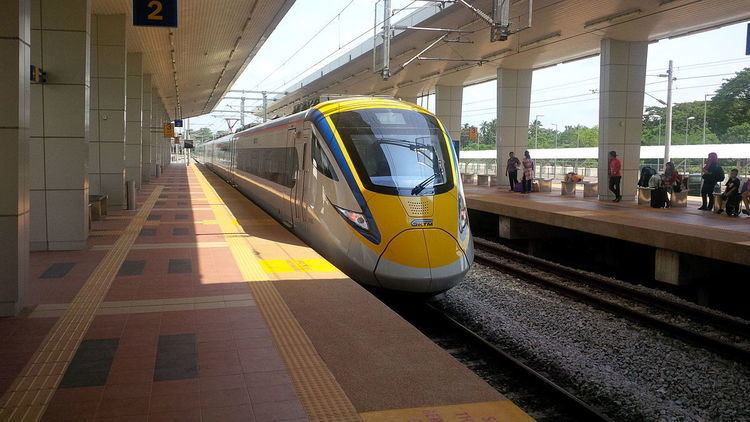In service September 2015 Built at Zhuzhou, China Number in service 60 cars (10 sets) | Manufacturer CSR Zhuzhou Constructed 2013 - 2015 Formation 6 cars per trainset | |
 | ||
The Class 93 is a type of electric multiple unit ordered by Keretapi Tanah Melayu for its intercity Electric Train Service (ETS). A total of 10 sets in 6-car formations are in the process of being built and delivered by CSR Zhuzhou of China. As per the technology exchange agreement, part of the consignment shall be partially assembled in Batu Gajah Malaysia.
Contents
The Class 93 ETS will be serving the northern route of the electrified double tracking project (EDTP) expanding upon current ETS rail service beyond Ipoh, to destinations such as Butterworth, Alor Setar, until the Malaysian border station of Padang Besar. Field testing of the KTM Class 93 sets have found that utilizing the present upgraded electrified double track, it is possible for the train to reach Padang Besar from Kuala Lumpur within four hours and fifteen minutes, with 5 stops at hand, while the Kuala Lumpur-Penang leg can be covered within 3 hours.
The rolling stock were to have been put into operation for the launch of the ETS Transit service between Ipoh and Padang Besar and the ETS Ekspres service between KL Sentral and Padang Besar. However, reports of problems during the testing and commissioning of the train sets had resulted in the Malaysian land public transport regulator, SPAD, not approving the trains for use in time for the launch of the two services on 10 July 2015 and 11 July 2015.
Design
The KTM Class 93 is a custom built train engineered to high speed metre gauge operation. Dubbed the "Malaysian Bullet Train", or "Pocket Rocket", it features a streamline sloped head, with better aerodynamic efficiency relative to previous KTM rail classes. It is expected to be one of the fastest trains operating on metre gauge track. Relative to KTM standard meter gauge bogies, special higher strength materials were used in bogie construction. This is done in order to damp and sustain the higher stresses incurred by going at high speed over narrow gauge.
The train uses a standard light weight aluminum body. The train is capable of starting at 0.7 metres per second per second (140 ft/s/min), thus being able to accelerate from 0 to 160 km/h (99 mph) in two minutes. It is capable of stopping within a minute and half from a kilometer away (0.7 mile) at speed. The rail class also features standard safety systems such as a hotbox alarm system installation, horizontal stabilizer, vehicle health monitoring systems and other advanced safety equipment. Unlike the earlier KTM Class 91, the KTM Class 93 reportedly sources all its components from China, with the exception of the on-board equipment (such as is the ATP) which is sourced from the Chinese subsidiary of Bombardier.
The intercity role of Class 93 requires longer station dwell times and a higher passenger seating comfort, so they have been designed with single leaf doors at each end and side of each carriage, fitted with end to end traverse 2+2 seating. In addition to this, it also features standard intercity offerings such as luggage racks, a toilet and prayer area within the length of an individual 6-car set. It has gang-ways interconnecting each coach, allowing passengers unrestricted movement throughout the entire length of the train. CCTV and 3-pin power outlets are provided as further features. Since these trains will operate in a tropical climate, they have over-head air-conditioning systems, providing temperature control, ventilation and dehumidification to maximise passenger comfort. The trains are also equipped with LTE-enabled WiFi throughout but currently it has not been turned on yet.
Each train set costs RM50 million.
Testing and Commissioning
Before launch, all new trainsets must undergo and pass compulsory testing, in this they are required to go 10,000 km without logging a single fault. The trainset will undergo testing for its automatic train protection system (ATP), other components tested included the propulsion system, the brakes, air-conditioning, door operations, auxiliary power supply, suspension, train control and management system, couplers, and even the wipers.
Delays to the July launch were attributed to ATP warnings whenever ETS201 enters the Butterworth branch line. Thus regulatory approval was not given for quite some time.
Four sets went into service on 10 October 2015, operating between Padang Besar and Gemas on the ETS Ekspres service. The fifth set is already undergoing testing after construction in Malaysia while the rest are still under construction.
Procurement
The purchase of KTM class 93 was made under a bilateral trade agreement between the Malaysian Ministry of Transport and the Chinese Transport Ministry with the contract signed in September 2013. On top of this, the agreement includes a 2-year maintenance agreement. It also includes various aspects including financing, construction of transportation facilities and other turnkey contracts as well as the transfer of advanced technology and management methods.
The procurement of the Class 93 includes a clause that future sets of the series would be assembled in Malaysia. A CSR facility for maintaining and assembling is in the process of being commissioned in Batu Gajah, Ipoh, Malaysia to assist on this end.
Launch date
The first of the 6-car Class 93 EMUs has finally entered service on 3 September ETS 201 began service by operating the 5AM service from Ipoh to Kuala Lumpur Sentral (EG9301). The ETS then operated the 9.30AM KL Sentral to Padang Besar service (EG9208).
By October 2015, four of ten the KTM class 93 sets (ETS201 - ETS204) were already in service to serve the Gemas - Padang Besar and Gemas - Butterworth route.
Formation
Cars 2 and 5 are equipped with a double-arm Z-shaped pantograph.
